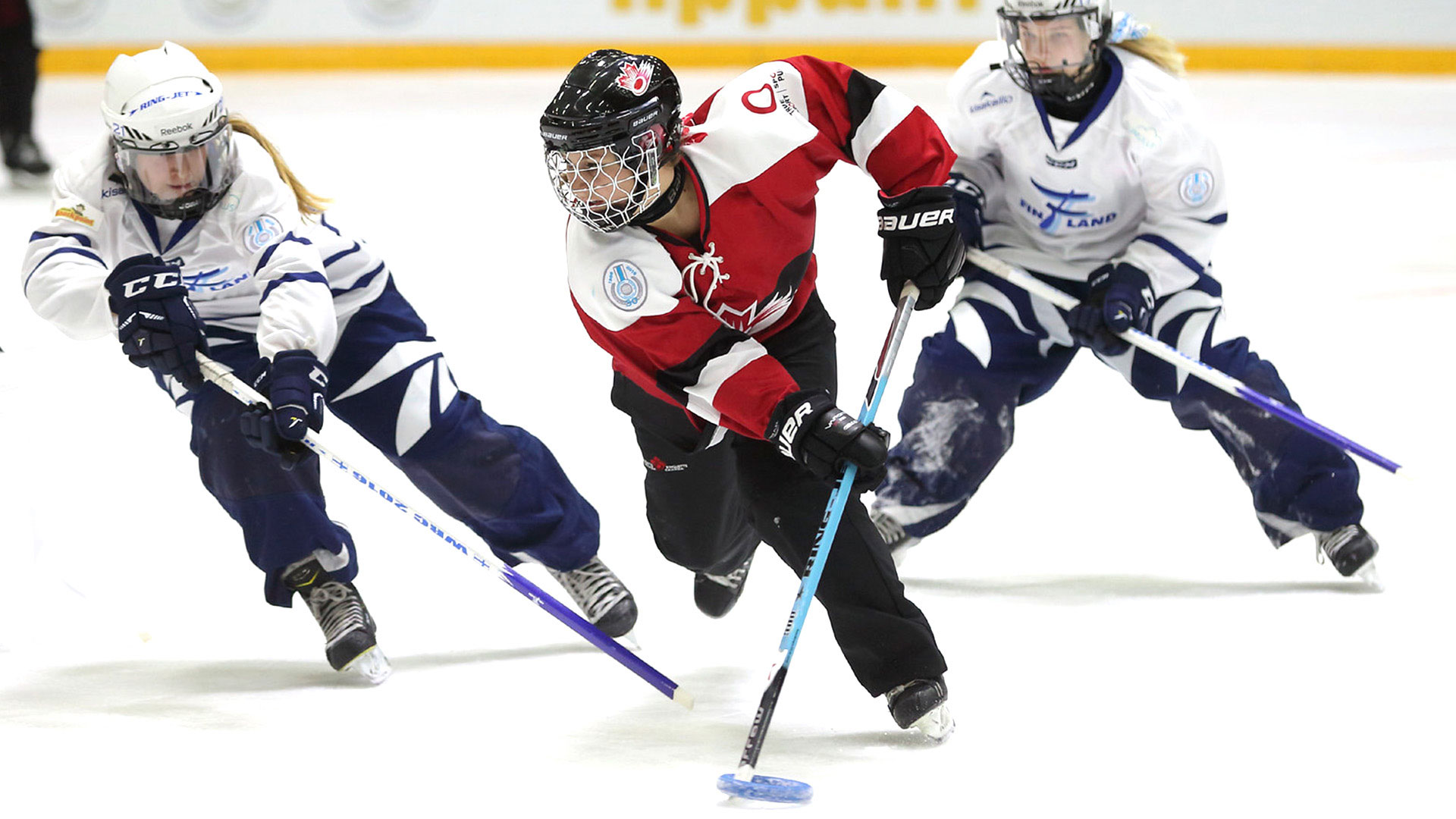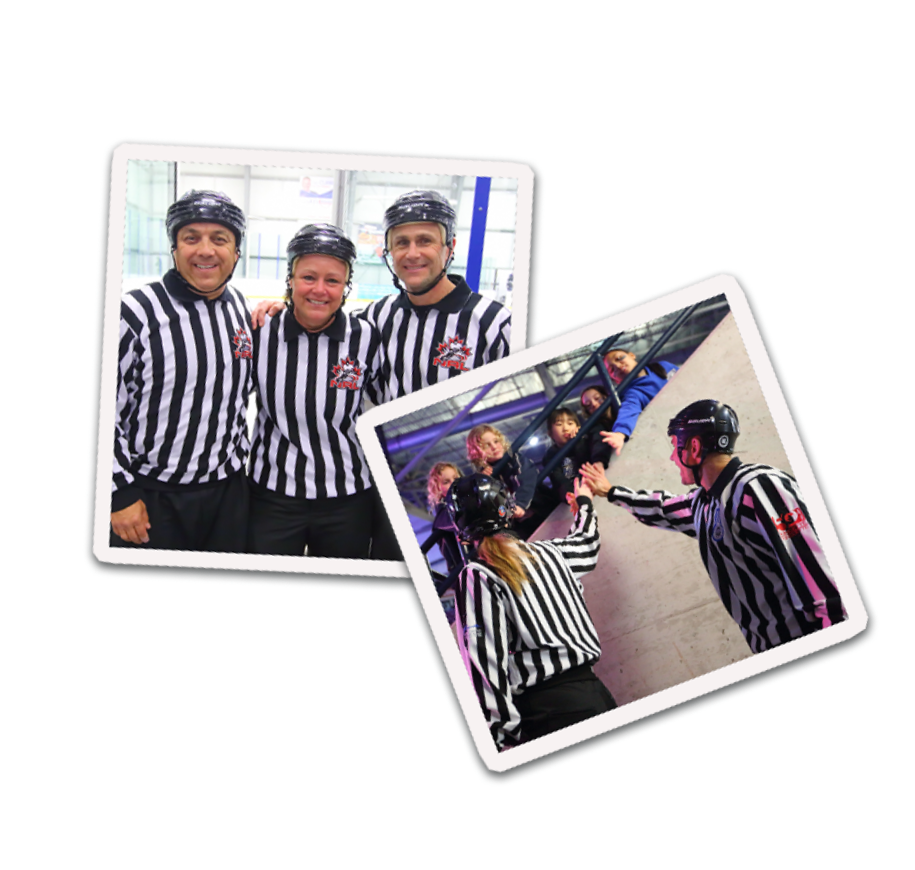
What is Ringette
A fast, fun and competitive team sport
Ringette is a uniquely Canadian winter sport that's as challenging as it is enjoyable. Created in 1963 in Canada, it has since been dubbed the fastest sport on ice.
The main objective of ringette is to use a stick to hit a ring into the opposing team's goal. The team with the highest score at the end wins.
Ringette is a great choice if you're looking for a safe competitive sport for your child. They'll learn to skate, pass, and play in a team—all while making friends and having fun. Here are some other reasons to choose ringette.
Ready to start your ringette journey?
With so many reasons to play ringette, the only question that remains is whether or not you're ready to get hooked on this addictive sport. If you're up for the challenge, we can help you carve a path for yourself or your child.
- Team sport in which players pass to win.
- Competition at every skill level.
- Safe, no-contact policy.
- Fun and fulfilling at any age.
- Friendships for a lifetime.
With ringette teams for every skill level, there's no limit to where your child can go. From recreational to elite leagues, there are plenty of chances for your child to excell.
Many young players develop an instant passion for the sport, relishing the chance to become agile, fluid skaters while having fun. They also enjoy being part of a great community as they build relationships in their team and across the country.
Who knows, they may even make it all the way to the National Ringette League and be part of the best ringette team in the world!
How to play ringette
Want to Play the FastestSport On Ice?
Learn the basics of ringette and try it for yourself. There’s no limit to where the ice can take you!
We shoot, we score!
The rules of ringette make it a true team sport. In order to win, the whole team must shine. The no-contact policy and constant passing make it easy to work together toward a common goal. As we like to put it, the team that scores together, stays together.
The goal
The objective of the game is to use a ringette stick to hit a ring into the opposing team's goalnet. The team with the most goals at the end wins.
The players
Each team has six players on the ice: two defence, two forwards, a centre and a goalie.
The equipment
How is ringette different than hockey?
At first glance, you might think that ringette looks just like hockey. But there are many key differences that set ringette apart from hockey—or any other ice sport, for that matter.
30-second shot clock: The short shot clock leads to a fast-paced game that requires constant motion.
Everyone wins: The fast pace and constant passing of ringette discourages ring hogs and fosters teamwork.
No-contact policy: There is no intentional body contact, making it much safer than hockey.
Straight stick: Sticks are straight with a specialized tip.
Hollow ring: Rather than a puck, ringette uses a 6-inch rubber ring.
No face-offs: Any stoppage results in a free pass to restart the game.
No offsides: Players can't carry the ring over a blue line. They must pass the ring over a blue line to a teammate.
More protection: Ringette cages (masks) are made with tight triangular or horizontal bars to prevent the stick from penetrating.
When played recreationally, ringette has two 24-minute periods. However, once you get to the big leagues—the National Ringette League, to be exact—the game is played in four quarters of 13 minutes each.
One of the elements that makes ringette so fast and fun is the 30-second shot clock. The team that has the ring has 30 seconds to shoot. (This rule doesn't apply in the younger U9 and U10 teams.)
Carrying the ring over the blue lines is a definite no-no in ringette. Instead, players must pass the ring over a blue line to a teammate. The other player can skate ahead to receive the ring. Now that's teamwork!
The free play lines (small red lines at the top of the circles) mark the restricted area of each team's attacking and defending zones. Only three players from each team are allowed in this area, plus the defending goalie.
From the free play line to the end boards, it's a game of three on three with lots of movement and creativity.
The goaltender has their own little piece of private rink real estate and it's called the goal crease. This is essentially a no trespassing zone that other players can't enter.
Only the goalie can play a ring that has touched or entered the goal crease. Because ringette is a game of speed, the goalie only has five seconds to pass the ring to a teammate.
Ringette promotes a no-contact policy. This means that excessive contact with another player can lead to penalties. Players are encouraged to play hard and stay safe by avoiding body-checking, tripping or hitting other players.
Ringette violations are usually for improper movement or ring handling.
Common violations:
- Entering the goal crease.
- Touching the ring on either side of the blue line.
- Four players in the offensive zone.
When a minor penalty occurs, the offending player must sit in the penalty box for two minutes. For a major penalty, the amount of time in the penalty box is four minutes.
Examples of minor penalties:
- Charging
- Cross checking
- Elbowing
- High-sticking
- Unsportsmanlike conduct
Major penalties usually occur when a player intends to cause harm to another player. They may also involve a player intentionally incurring a penalty to prevent the other team from taking a shot.
